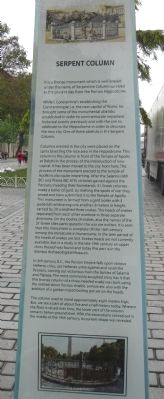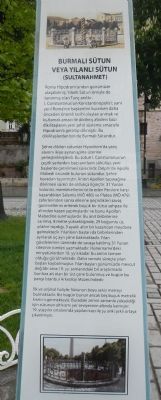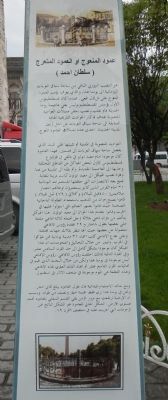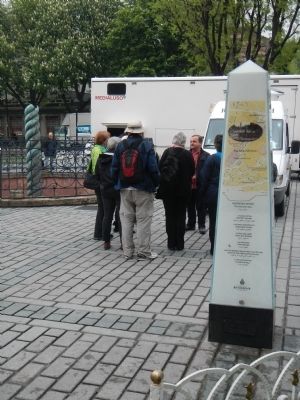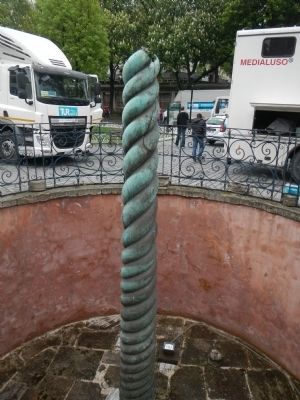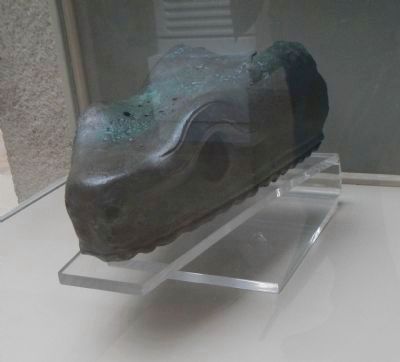Sultan Ahmet in İstanbul in Fatih, Turkey — West Asia or Southeast Europe
Serpent Column
Burmalı Sütun Veya Yılanlı Sütun (Sultanahmet)
It is a Bronze monument which is well-known under the name of Serpentine Column survived to the present day from the Roman Hippodrome.
While I. Constantine's establishing the Constantinople; i.e. the new capital of Rome, he brought some of the monumental obelisks established in order to commemorate important historical events previously and with the aim to celebrate to the Hippodrome in order to decorate the new city. One of these obelisks is the Serpent Column.
Columns erected in the city were placed on the spina bisecting the race area in the Hippodrome. This column is the column in front of the Temple ofApollo at Delphi in the process of the introduction of new capital. It has been moved to the city from here. The process of the monument erected to the temple of Apollo is also quite interesting. After the Salamis (480 BC) and Platea (BC 479) victories gained against the Persians invading their homelands, 31 Greek colonies made a boiler of gold, by melting the spoils of war they seized and have submitted it to the Temple of Apollo. This monument is formed from a gold boiler with 3 pedestals embracing one another, 8 meters in height, carried by 29 wreathed three snakes. The heads of snakes separated from each other overlook in three separate directions. On the bodies of snakes, also the names of the 31 Greek sites participated in the war are written. It is seen that this monument is complete till the 16th century among the miniatures in Hunername. In the later period of the heads of snakes are lost. Snakes heads are not currently available, but in a study in the late 19th century an upper chins thereof was found and today this part is in the Istanbul Archaeological Museum.
In 5th century B.C., the Persian Empire falls upon various Hellenic cities, yet Hellenes unite against and resist the Persians, coming out victorious from the battles of Salamis and Plataea. The most commonly accepted story has it that this bronze column of a threeheaded snake was built using the melted-down Persian shields, armors etc. also with the addition of a golden tripod boiling pot set on the heads.
The column used to stand approximately eight meters high. But, we see a part of about five and a half meters today. Wherein the floor is raised over time, the lower part of the column remains below ground level. With the excavations carried out in the middle of the 19th century, its current shape was revealed.
Turkish:
Roma Hipodrom'undan günümüze ulaşabilmiş, Yılanlı Sütun ismiyle de tanınmış olan Tunç anıttır.
l. Constantlnus'un Konstantinopolis'i; yani yeni Roma'nın
başkentini kurarken daha önceden onemli tarihi olayları anmak ve kutlamak amacı ıle dikilmiş abidevi bazı dikilitaşlarını yeni şehri süsleme amacıyla Hipodroma getirtirp dikmiştir. Bu dikilitaşlardan biri de Burmalı Sütundur.
Şehre dikilen sütunlar Hipodrom'da yarış alanını ikiye ayıran spina üzerine yerleştirilmişlerdi. Bu sütun l. Constantinıus'un çeşitli yerlerden bazı anıtların sökülüp, yeni başkente getirilmesi sürecinde: Delphi'de Apollo Mabedi önünde bulunan sütundur. Şehre buradan taşınmıştır, Anıtın Apollon tapınağına dikilmesi süreci de oldukça ilginçtir. 31 Yunan kolonisi, memleketlerini istila eden Perslere karşı kazandıkları Salamis (MÖ 480) ve Platea (MÖ 479) zaferlerinden sonra ellerine geçirdikleri savaş ganimetlerini eriterek büyük bir tütsü sehpası ile altından kazan yapmışlardır ve bunu Apollon Mabedine sunmuşlardır. Bu anıt birbirlerine sarılmış, 8 metre yüksekliğinde, 29 boğumlu üç yılanın taşıdığı, 3 ayaklı altın bir kazandan meydana gelmektedir. Yılanların başları da birbirlerinden ayrılarak üç ayrı yöne bakmaktadır. Yılan gövdelerinin üzerinde de savaşa katılmış 31 Yunan sitesinin isimleri yazmaktadır. Hünername'deki minyatürlerden 16. yy'a kadar bu anıtın tamam olduğu görülmektedir. Daha sonraki süreçte yılan başları kaybolmuştur. Yılan başları günümüzde mevcut değildir ama 19. yy. sonlarındaki bir araştırmada bunlara ait olan bir üst çene bulunmuş ve bugün bu parça İstanbul Arkeoloji Müzesi'ndedir.
İlk ve orijinal haliyle; Sütunun boyu sekiz metreyi bulmaktadır. Biz bugün bunun ancak bes buçuk metrelik kısmını görmekteyiz. Buradaki zemin zamanla yükseldiği için sütunun alt kısmı yer seviyesinin altında kalmıştır. 19. yüzyılın ortalarında yapılan kazı ile şu anki şekli ortaya çıkarılmıştır.
Arabic: To read the Arabic text, click on the Arabic image to enlarge it.
Erected by Istanbul Büyükşehir Belediyesi (Istanbul Metropolitan Municipality).
Topics. This historical marker is listed in this topic list: Arts, Letters, Music.
Location. 41° 0.368′ N, 28° 58.538′ E. Marker is in İstanbul, in Fatih. It is in Sultan Ahmet. Marker is on Atmeydanı Caddesi close to Trephine Sokak. Touch for map. Marker is at or near this postal address: Atmeydanı Cd 21, İstanbul 34122, Turkey. Touch for directions.
Other nearby markers. At least 8 other markers are within walking distance of this marker. Obelisk of Theodosius (within shouting distance of this marker); Walled Obelisk (within shouting distance of this marker); German Fountain (about 120 meters away, measured in a direct line); St. Euphemia's Martyrion (about 180 meters away); Mausoleum of Sultan Ahmed I (about 180 meters away); Cistern of Philoxenos (about 210 meters away); Firuz Aga Mosque (about 210 meters away); The Milion Stone (approx. 0.3 kilometers away). Touch for a list and map of all markers in İstanbul.
More about this marker. The Serpent Column is located at the southwest end of the Hippodrome.
Credits. This page was last revised on February 13, 2023. It was originally submitted on June 22, 2015, by Barry Swackhamer of Brentwood, California. This page has been viewed 491 times since then and 27 times this year. Last updated on June 25, 2015, by Barry Swackhamer of Brentwood, California. Photos: 1, 2, 3, 4, 5, 6. submitted on June 22, 2015, by Barry Swackhamer of Brentwood, California. • Bill Pfingsten was the editor who published this page.
